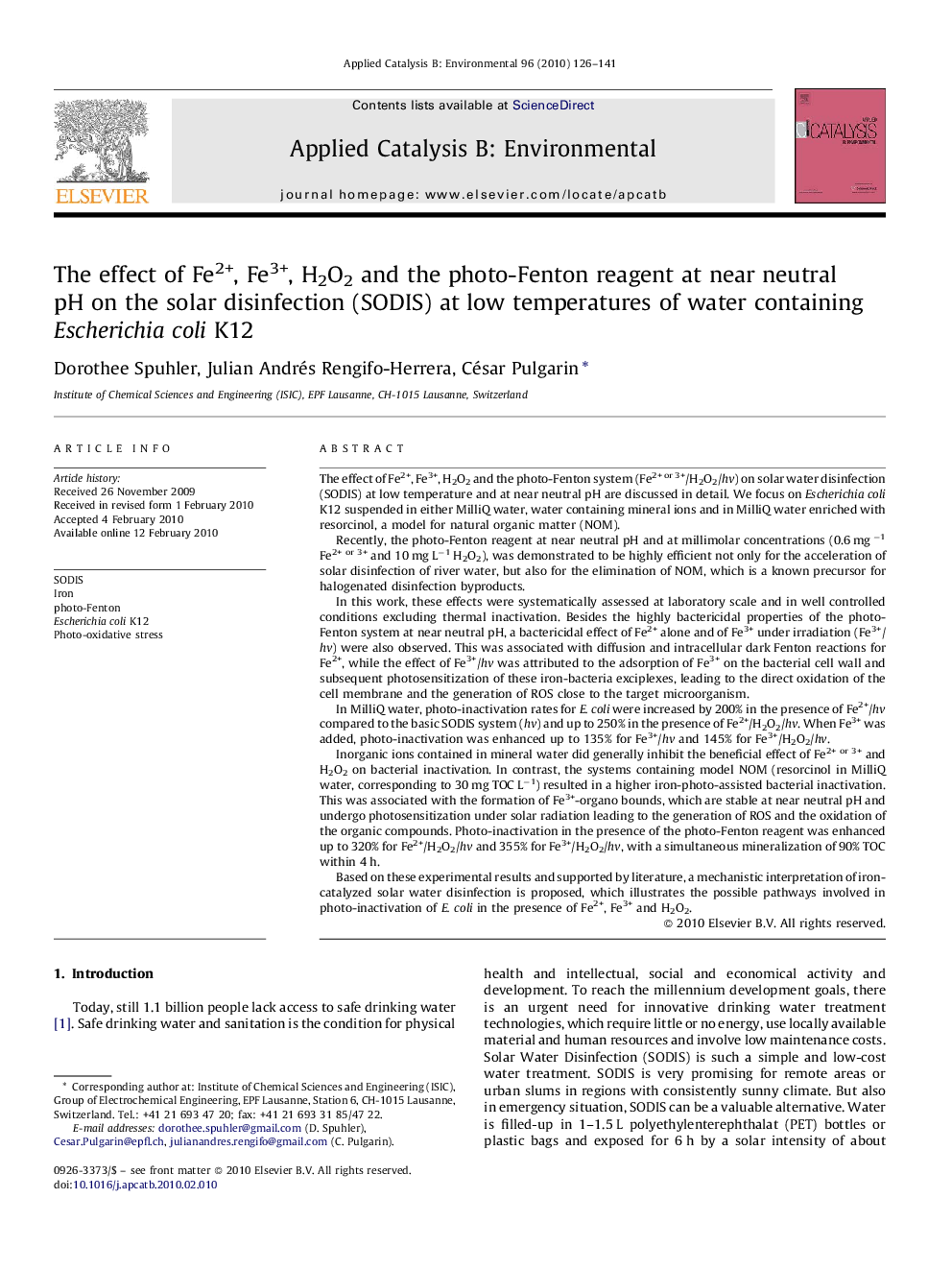| کد مقاله | کد نشریه | سال انتشار | مقاله انگلیسی | نسخه تمام متن |
|---|---|---|---|---|
| 47454 | 46472 | 2010 | 16 صفحه PDF | دانلود رایگان |

The effect of Fe2+, Fe3+, H2O2 and the photo-Fenton system (Fe2+ or 3+/H2O2/hv) on solar water disinfection (SODIS) at low temperature and at near neutral pH are discussed in detail. We focus on Escherichia coli K12 suspended in either MilliQ water, water containing mineral ions and in MilliQ water enriched with resorcinol, a model for natural organic matter (NOM).Recently, the photo-Fenton reagent at near neutral pH and at millimolar concentrations (0.6 mg −1 Fe2+ or 3+ and 10 mg L−1 H2O2), was demonstrated to be highly efficient not only for the acceleration of solar disinfection of river water, but also for the elimination of NOM, which is a known precursor for halogenated disinfection byproducts.In this work, these effects were systematically assessed at laboratory scale and in well controlled conditions excluding thermal inactivation. Besides the highly bactericidal properties of the photo-Fenton system at near neutral pH, a bactericidal effect of Fe2+ alone and of Fe3+ under irradiation (Fe3+/hv) were also observed. This was associated with diffusion and intracellular dark Fenton reactions for Fe2+, while the effect of Fe3+/hv was attributed to the adsorption of Fe3+ on the bacterial cell wall and subsequent photosensitization of these iron-bacteria exciplexes, leading to the direct oxidation of the cell membrane and the generation of ROS close to the target microorganism.In MilliQ water, photo-inactivation rates for E. coli were increased by 200% in the presence of Fe2+/hv compared to the basic SODIS system (hv) and up to 250% in the presence of Fe2+/H2O2/hv. When Fe3+ was added, photo-inactivation was enhanced up to 135% for Fe3+/hv and 145% for Fe3+/H2O2/hv.Inorganic ions contained in mineral water did generally inhibit the beneficial effect of Fe2+ or 3+ and H2O2 on bacterial inactivation. In contrast, the systems containing model NOM (resorcinol in MilliQ water, corresponding to 30 mg TOC L−1) resulted in a higher iron-photo-assisted bacterial inactivation. This was associated with the formation of Fe3+-organo bounds, which are stable at near neutral pH and undergo photosensitization under solar radiation leading to the generation of ROS and the oxidation of the organic compounds. Photo-inactivation in the presence of the photo-Fenton reagent was enhanced up to 320% for Fe2+/H2O2/hv and 355% for Fe3+/H2O2/hv, with a simultaneous mineralization of 90% TOC within 4 h.Based on these experimental results and supported by literature, a mechanistic interpretation of iron-catalyzed solar water disinfection is proposed, which illustrates the possible pathways involved in photo-inactivation of E. coli in the presence of Fe2+, Fe3+ and H2O2.
Journal: Applied Catalysis B: Environmental - Volume 96, Issues 1–2, 26 April 2010, Pages 126–141